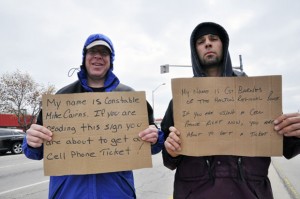A new anti-cell phone driving campaign, currently being championed by various Canadian police agencies, referred to as “hobo cops”, has inadvertently illustrated some interesting SRV concepts.
The program itself consists of undercover police officers, dressed as homeless men, who stand at roadside medians and appear to be asking for change during traffic stoppages. Upon closer inspection however, the officers are holding signs which say something to the affect of “if you are using your cell phone you will be getting a ticket”, as can be seen in the picture below.
(Photograph copyright National Post, 2012)
The first SRV issue concerns imagery in general. As is clear from the picture and the article itself, the officers are dressing themselves in ways which play into the stereotyped appearance of homeless men. In fact, in the article the officers discuss how they have attempted to dress themselves up in order to appear more authentically homeless:
“And in an apparent Canadian first in the genre, RCMP Constable Bryan Martell in Chilliwack, B.C., has been wearing a hoodie pulled up over a baseball cap with a pair of baggy, combat fatigue pants while clutching his greasy, cardboard sign written in all capital letters”.
While this stereotyping is indicative of devalued status for homeless people, it also highlights the importance of imagery in defining a role. While there are many factors that contribute to someone being in the “homeless person” role, this story makes clear that one’s appearance is an essential part of the role. Indeed, the cardboard sign has become such a ubiquitous indication that a person is in the homeless role that it is possible to predict that many motorists fail to read the signs of the approaching police officers and may not even be aware that they have been issued a ticket.
According to Wolfensberger (2009), appearance features “…act as cues that prompt observers to cast the observed person into a particular valued or devalued role” (p. 17). Here, the cues can be taken straight from the quote referenced earlier: hoodie pulled up over a baseball cap, baggy combat fatigue pants and a greasy, cardboard sign written in capital letters.
In many ways, this campaign appears to be a bizarre reversal of the concept of donning attire in order to assume a valued role. Wolfensberger refers to historical examples of people who have put on a doctor’s white coat, walked into a hospital and then were assumed by everyone present to actually be a doctor (p. 35).
Interestingly, a spokesperson from the Ontario Coalition Against Poverty objects to the police officers campaign on the grounds that it is a “deviancy-image juxtaposition” for homeless people. While the spokesperson doesn’t use those exact SRV terms, it is fairly clear from his statement that those are the grounds on which he is objecting: “We don’t want to give panhandlers a bad name by people thinking that they’re cops”.
Steve Tiffany
References:
Wolfensberger, W. (2009). Observing, recording and addressing personal physical appearance by means of the APPEAR tool. Syracuse, NY, USA: Syracuse University Training Institute for Human Service Planning, Leadership & Change Agentry; & Plantagenet, ON, Canada: l’Institut Valor Institute.
